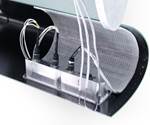Embraer, Collins Aerospace demonstrate CNT-based ice protection system
Electro-thermal heating system based on MEA technologies lowers energy requirements, adverse effects of ice and lightens weight, is undergoing flight testing on Embraer Phenom 300E jet.
Share
Read Next
A collaboration between Embraer (São Paulo, Brazil) and Collins Aerospace (Charlotte, N.C., U.S.) has culminated in the development and demonstration of a carbon nanotube (CNT) electro-thermal heating system that seeks to result in more efficient and sustainable aircraft. On July 20, the two companies began a flight test campaign in Gavião Peixoto, Brazil, for the advanced ice protection system.
Collins’ CNT heater and ice protection controller were successfully integrated on the vertical stabilizer and flight tested in Embraer’s fully functional Phenom 300E light jet prototype aircraft, executing more than 10 hours of ground and “dry air” flight tests. The successful first flight in Dec. 2021 demonstrated the seamless integration of the new technology, according to Embraer.
“We are encouraged by the recent test results, and we are convinced that this innovative technology will meet our ambitious technological and sustainability roadmap,” Luís Carlos Affonso, senior vice president, engineering, Technology Development and Corporate Strategy at Embraer, says. “We are glad to have Collins on this journey to explore further partnership opportunities that will help create a net zero carbon aviation industry.”
Heaters based on CNT technology are said to present significant advantages when compared to existing metallic heaters. Major benefits include eliminating the chemical etching process, lowering the energy requirement by 25% at system level and minimizing aerodynamic adverse effects caused by ice. The CNT’s heater element is also much lighter than a conventional metallic heater, features enhanced damage tolerance and should result in a longer product life cycle.
“This electrothermal CNT technology is more energy efficient, lighter and uses greener manufacturing processes than current systems, and we believe it will become the future standard for ice protection — including those in more electric aircraft designs,” Dr. Mauro Atalla, senior vice president of engineering and technology for Collins Aerospace, notes. “Collaborations such as the one between Collins and Embraer are helping innovations like this come to market more quickly.”
The evaluation of flight condition was possible after the conclusion of parameters evaluation, structural, electromagnetic compatibility and more than 500 hours in the icing tunnel, among other tests that have made steady progress in recent years. The technological and research activities aim to further increase the technology readiness level by conducting additional ground tests and flying in natural icing conditions.
The project is part of the More Electric Aircraft (MEA) technologies development approach, which includes a series of industry initiatives to ensure the commitment to net-zero emission by 2050.
Related Content
-
Cryo-compressed hydrogen, the best solution for storage and refueling stations?
Cryomotive’s CRYOGAS solution claims the highest storage density, lowest refueling cost and widest operating range without H2 losses while using one-fifth the carbon fiber required in compressed gas tanks.
-
Plant tour: Joby Aviation, Marina, Calif., U.S.
As the advanced air mobility market begins to take shape, market leader Joby Aviation works to industrialize composites manufacturing for its first-generation, composites-intensive, all-electric air taxi.
-
Infinite Composites: Type V tanks for space, hydrogen, automotive and more
After a decade of proving its linerless, weight-saving composite tanks with NASA and more than 30 aerospace companies, this CryoSphere pioneer is scaling for growth in commercial space and sustainable transportation on Earth.
















.jpg;maxWidth=300;quality=90)
